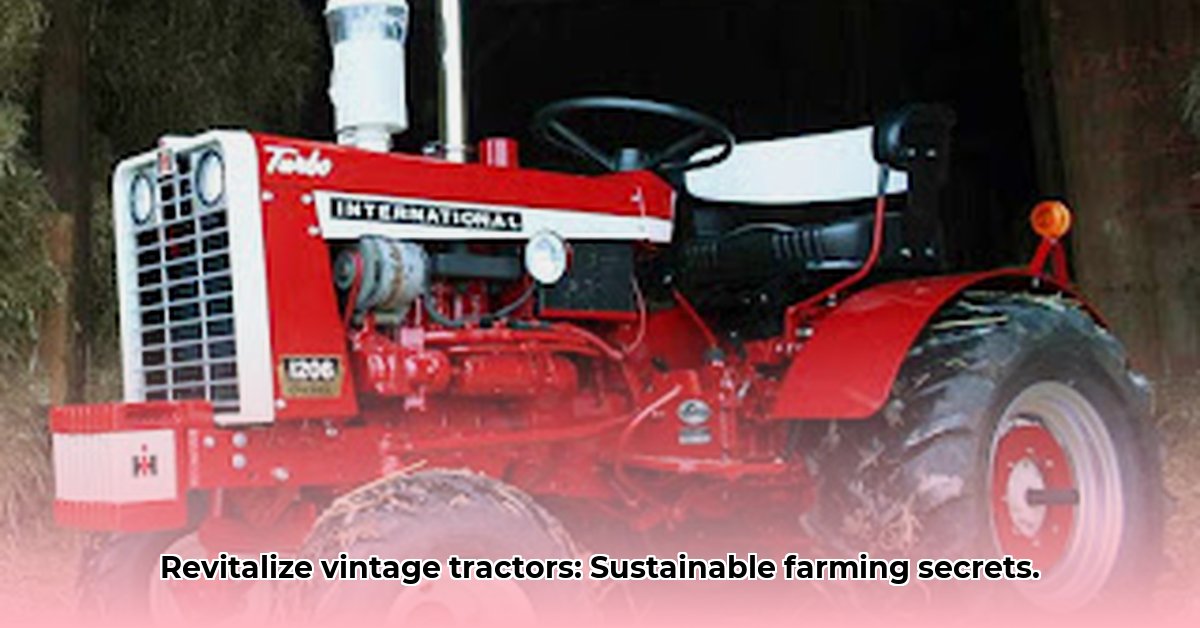
Finding the Right Tractor: Your Sustainable Farming Partner
Before embarking on your search for a vintage tractor, carefully consider your farming needs. What's the size of your land? What crops will you be cultivating? These factors will determine the appropriate horsepower and features for your tractor. A small garden might only require a low-horsepower model, while a larger farm might necessitate a more powerful machine. Remember – choosing a tractor that's too powerful will lead to unnecessary fuel consumption and higher operating costs; a tractor that's too small will limit your productivity.
Where can you find these reliable workhorses? Online marketplaces like eBay and Craigslist are excellent starting points, offering a wide selection of older tractors. Local auctions are another great avenue for discovering hidden gems. Don't overlook the power of word-of-mouth; networking with fellow farmers can often uncover tractors that are not yet publicly listed. Finally, thorough research on specific tractor models is critical. Understanding their reputation for reliability and the availability of spare parts will save countless headaches down the line. For specific parts, check out this helpful resource: Ford 8N parts.
Pre-Purchase Inspection: A Crucial Step for Sustainable Farming
Never underestimate the importance of a comprehensive pre-purchase inspection. This critical step could save you from costly repairs or even a completely unusable tractor. Here’s a step-by-step guide:
1. Engine Evaluation: Listen carefully for unusual noises like knocking or rattling. Inspect for any signs of leaks, such as oil stains or coolant dripping. A compression test will reveal the health of your engine—low compression indicates potential problems. Excessive smoke from the exhaust also warrants further investigation. Lastly, check if the engine starts and runs smoothly.
2. Transmission Test: Shift through all the gears, both forward and reverse. Any grinding, hesitation, or difficulty shifting indicates potential transmission issues requiring immediate attention.
3. Hydraulic System Check: Thoroughly test the lift, three-point hitch (3PH), and power take-off (PTO) functions. All should operate smoothly and responsively. Leaks or sluggish movement point toward potential hydraulic system problems.
4. Tire Condition & Inflation: Inspect the tires for wear and tear. Deep tread wear implies significant use and possible structural damage. Check tire pressure; improperly inflated tires affect traction and fuel efficiency.
5. Brake Test: Ensure the brakes function effectively and consistently. Safety is paramount!
6. Electrical System Check: Test all lights, gauges, and other electrical components to ensure everything operates correctly.
7. Overall Condition Assessment: Finally, conduct a visual inspection to assess the overall condition of the tractor. Look for excessive rust, significant dents, signs of previous repairs, and any indications of neglect.
Restoration and Maintenance: Keeping Your Tractor in Top Shape
Owning an older tractor is a rewarding experience, but without regular maintenance, it can quickly become a liability. Regular maintenance is a crucial aspect of sustainable farming, maximizing the lifespan of your equipment and minimizing downtime.
- Regular Oil Changes: Follow the manufacturer’s recommendations for oil type and change intervals. This prevents engine wear and prolongs the engine's life.
- Filter Replacements: Replace air, fuel, and oil filters regularly. Clean filters prevent contaminants from damaging sensitive engine components.
- Fluid Level Checks: Routinely check the levels of coolant, transmission fluid, and hydraulic fluid. Maintaining correct levels prevents damage and ensures optimal performance.
- Lubrication: Regularly grease all zerk fittings to reduce friction and wear on moving parts.
- Part Sourcing: Identify reliable parts suppliers. This could involve local mechanics, online tractor parts forums, or specialized vendors.
Following these steps will ensure your tractor remains a productive and reliable asset for years to come.
Sustainable Practices: Farming Responsibly
Integrating sustainable practices into your farming operation is not merely an environmental responsibility, but also a path to greater efficiency and cost-effectiveness.
- Fuel Efficiency: Proper maintenance is crucial for maximizing fuel efficiency. Avoid unnecessary idling, and make sure tires are properly inflated. Utilizing the correct grade of oil also plays a significant role in minimizing fuel consumption.
- Low-Till Farming: This farming method reduces soil erosion, conserves moisture, and minimizes fuel usage compared to traditional plowing techniques.
- Precision Farming: Even without advanced GPS technology, careful planning and efficient field management significantly reduce fuel consumption and resource waste.
- Waste Management: Properly recycle used oil and other fluids. This demonstrates responsible environmental stewardship.
Modernizing Your Tractor (Optional): Strategic Upgrades
Consider upgrading your tractor, but approach it strategically and realistically. A GPS guidance system can optimize field coverage, reducing fuel consumption and improving efficiency. However, these upgrades can be costly, and their suitability depends on your tractor's model and condition. Consider the cost-benefit carefully; a minor, affordable upgrade can often be more practical than major modifications. Always verify compatibility with your chosen tractor model before proceeding.
Key Takeaway: Restoring and maintaining a small, old tractor is a sustainable and rewarding endeavor. With thorough planning, regular maintenance, and responsible practices, your vintage machine will be a valuable partner for years to come, contributing to both your personal success and environmental sustainability.